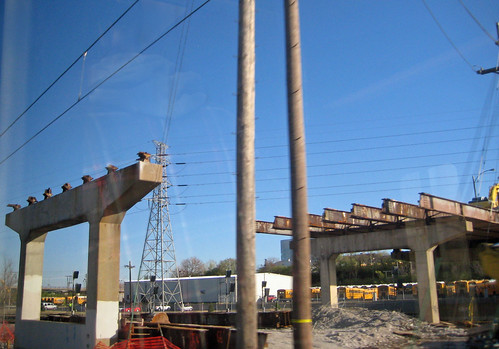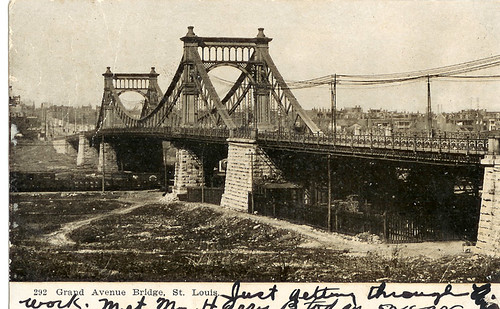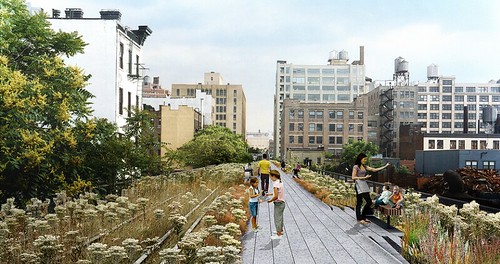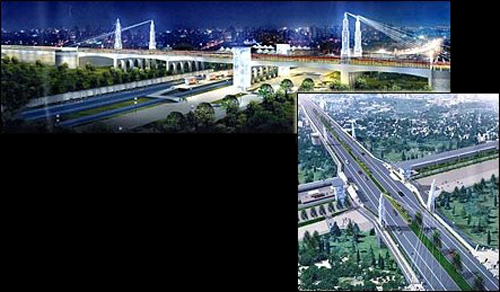
Closed to traffic and partially demolished over a decade ago, the remaining leg of the Spring Avenue Viaduct is currently being demolished, permanently severing a connection across the Mill Creek Valley and rail yards that separate South St. Louis from the Central Corridor. Urban Review did a post about the viaduct in 2007 with a very nice series of photos.

The Spring Avenue viaduct opened at the beginning of 1960 to act as a traffic reliever for crowded Grand Avenue. This was especially important as the old Grand Avenue suspension bridge was about to be demolished and replaced with the current structure. In addition to losing a spectacular structure, the reconstruction also meant the end of the Grand Avenue streetcar line. The following was published in the Globe Democrat on January 4th, 1960:
Grand Streetcars Bow Out After 100 Years
Buses will bow in on Public Service Company's Grand Boulevard line Monday after a century of streetcar service. An "owl" streetcar leaving the water tower at the north end of the line at 1:37 a.m. will be Grand's last crosstown trolley. THE REASON
Public Service is switching to busses because of the scheduled demolition and replacement of the Grand Viaduct. The bus line will follow the streetcar route until that work begins in about a month. It will then be routed over the new Spring Avenue viaduct. Streetcar service on Grand dates to September 1859, when the Citizens Railway Company extended its line from Fourth and Morgan (now Delmar boulevard) to the Fair Grounds entrance near Grand and Natural Bridge Avenue. DRAWN BY HORSES
The first Grand cars were horse drawn. According to transit historian Berl Katz, steam powered cars made their St. Louis debut on Grand in 1865 but the line we back to horses about 1884. Cable came in three years later. Public service has been operating the Grand line since 1927. The shift to busses leaves streetcar operations only on four east-west lines - Delmar, Hodiamont, Wellston and University.Now almost 50 years later, the Grand Avenue bridge is scheduled for replacement again with a new structure. Grand Avenue will be closed between Chouteau Avenue and highway 40 during construction of the new bridge, but this time the Spring Avenue Viaduct will not be available as a detour route. Compton Avenue, twice the distance away from Grand than Spring, will be the nearest way around the closure.

While Grand does not have as much traffic today as in 1960 when the City's population was 750,000, it still has the City's busiest bus line. Even if it was not re-opened to auto traffic, the Spring Avenue Viaduct could have been used as a bike path and greenway similar to the Chain of Rocks Bridge or the High Line in New York City, which is scheduled to open later this year.

One thing worth noting about the coming re-construction of the Grand Avenue bridge is that the new renderings show the new elevator/stair towers from Grand down to MetroLink as being located north of the tracks instead of directly onto the MetroLink platform as they are currently. Metro's website goes one further and describes the location as also being north of Scott Avenue, which parallels MetroLink. I am not sure why the elevators need to be replaced in the first place, but this change does not make any sense. The majority of people using the stairs and elevators are transferring directly from MetroLink to the Grand Avenue Metro Bus or vice-versa. Now everyone will need to cross both a street and the west-bound MetroLink tracks to get to the platform.
An additional question: Will the new Grand Avenue bridge be able to accommodate a future revival of the Grand Avenue streetcar?


2 comments:
I don't know what's more pathetic, the demolition of the Spring Ave viaduct or the fact that it was only 49 years old. What a piece of junk.
The Old Grand Avenue bridge was beautiful. Yes they should allow for streetcars with any new bridge,if not it would be a totally pointless exercise.
Post a Comment